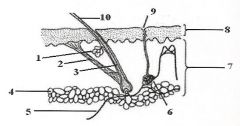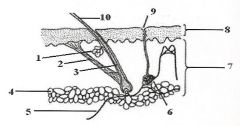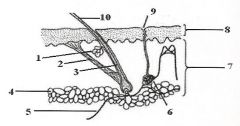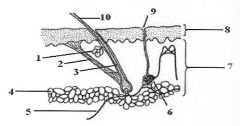![]()
![]()
![]()
Use LEFT and RIGHT arrow keys to navigate between flashcards;
Use UP and DOWN arrow keys to flip the card;
H to show hint;
A reads text to speech;
57 Cards in this Set
- Front
- Back
|
Which of these is NOT one of the senses?
A. hearing B. tasting C. sweat D. seeing |
C. sweat
|
|
|
Which statement is FALSE?
A. The outer layer of the skin is called the epidermis. B. The sweat glands make and give off perspiration. C. The tough and flexible covering of the body is called flesh. D. Little holes in the surface of the skin are called pores. |
C. The tough and flexible covering of the body is called flesh.
|
|
|
There are more nerve endings in the lips and the finger tips than in other parts of the body.
These nerve endings make the finger tips and lips _________________. A. highly sensitive B. red C. useful D. numb |
A. highly sensitive
|
|
|
Mr. Brown is a farmer. Everyday he works in the sunlight. Mr. Brown will most likely show a change in his
A. height B. age C. weight D. complexion |
D. complexion
|
|
|
Sweat is made up of
A. water and salts B. gas and salts C. carbon dioxide and water D. blood and tears |
A. water and salts
|
|

Use the diagram above to answer this question:
What name is given to the part of the diagram numbered 8? A. epidermis B. pore C. dermis D. sweat glands |
A. epidermis
|
|

Use the diagram above to answer this question:
What name is given to the part of the diagram numbered 6? A. skin surface B. hair follicle C. nerve D. sweat glands |
D. sweat glands
|
|

Use the diagram above to answer this question:
The part numbered 7 is the _______. A. epidermis B. fat cell C. pore D. dermis |
D. dermis
|
|

Use the diagram above to answer this question:
The hair shaft is labelled _______. A. 10 B. 3 C. 9 D. 5 |
A. 10
|
|

Use the diagram above to answer this question:
The part numbered 3 is the _________. A. hair follicle B. dermis C. epidermis D. hair shaft |
A. hair follicle
|
|
|
The largest organ in the human body is the ___________.
A. skin B. heart C. lungs D. kidney |
A. skin
|
|
|
The epidermis is the outer layer of the skin. What name is given to the inner layer of the skin?
A. carotene B. melanin C. dermis D. pigment |
C. dermis
|
|
|
Which organ in your body detects when the air around you gets hot or cold?
A. lungs B. skin C. kidney D. tongue |
B. skin
|
|
|
What name is given to the pigment from which human beings get their skin colour?
A. dermis B. epidermis C. carotene D. melanin |
D. melanin
|
|
|
The eyes, ears, nose, tongue and skin are called _____________.
A. sense organs B. sensory receptor C. pigment D. dermis |
A. sense organs
|
|
|
Everybody's skin is the same; the only difference is the amount of _________ each person's skin contains.
A. pigment B. stimulus C. sensory receptors D. dermis |
A. pigment
|
|
|
How can you keep your skin healthy?
A. By keeping it clean and taking plenty of rest. B. By eating a balanced diet and drinking plenty of water. C. All of the above D. None of the above |
C. All of the above
|
|
|
What name is given to a doctor who specializes in the care of the skin?
A. palaeontologists B. gynaecologist C. dermatologist D. entomologist |
C. dermatologist
|
|
|
The number of stimuli that the skin can receive is ______.
A. one B. two C. three D. four |
C. three
|
|
|
What name is given to the tiny bumps on the tongue?
A. saliva B. warts C. mucus D. taste buds or papillae |
D. taste buds or papillae
|
|
|
What are the four main tastes that your taste buds recognize?
A. ripe, green, sour, bitter B. sweet, sour, bitter, salty C. ripe, green, bitter, salty D. sour, sweet, green, bitter |
B. sweet, sour, bitter, salty
|
|
|
Which word best completes the blanks below?
The skin contains ___________which are mostly concentrated in the fingers, lips and tongue. The ____________ gather information about touch, temperature, pressure, and pain and send it to the brain for processing and reaction. A. stimulus B. sensory receptors C. dermis D. sense organs |
B. sensory receptors
|
|
|
The air we breathe is moistened and filtered by our ___________.
A. lungs B. nose C. mouth D. heart |
B. nose
|
|
|
What name is given to the moist, thin layer of tissue that lines the inside of the nose?
A. mucus membrane B. sensory cells C. olfactory nerve D. receptor cells |
A. mucus membrane
|
|
|
Which of these are covered with damped air and are found in the top of the nose?
A. throat B. receptor cells C. sensory cells D. olfactory nerve |
B. receptor cells
|
|
|
Which of these is able to detect seven basic odours?
A. olfactory nerve B. nostrils C. receptor cells D. sensory cells |
D. sensory cells
|
|
|
When you are ill and your nose is blocked, your sense of taste is reduced by the extra mucus in the ___
A. nasal passage B. olfactory nerve C. receptor cells D. sensory cells |
A. nasal passage
|
|
|
Another name for the taste buds is
A. papillae B. olfactory nerve C. sensory cells D. mucus membrane |
A. papillae
|
|
|
Which of these could best explain why Susan's food becomes tasteless?
A. She is ill. B. The food needs more salt. C. The food is overcooked. D. The food is raw. |
A. She is ill.
|
|
|
Air goes into the nose through the
A. mucus membrane B. papillae C. nostrils D. sensory cells |
C. nostrils
|
|
|
The sticky matter in your nose is called ____________
A. boogie B. mucus C. sensory cells D. olfactory nerve |
B. mucus
|
|
|
The taste and smell of foods are combined to give us their
A. scent B. colour C. nutrients D. flavours |
D. flavours
|
|
|
Which of the following traps germs, dust, and other small particles that may irritate your lungs?
A. olfactory nerve B. sensory cells C. receptor cells D. mucus |
D. mucus
|
|
|
You can't taste anything without some help from your
A. eyes B. throat C. nose D. hand |
C. nose
|
|
|
Which of the following would MOST LIKELY stimulate the taste buds in your tongue?
A. hot water B. cold water C. warm water D. mango juice |
D. mango juice
|
|
|
The sweat glands use urea, salt and water found in the body to make
A. sweat B. urine C. food D. blood |
A. sweat
|
|
|
Kim smells four different substances. Which is the odd one out?
A. bleach B. disinfectant C. perfume D. mango juice |
D. mango juice
|
|
|
|
|
|
|
Complex machines are made up of __
A. two or more machines. B. nuts and bolts. C. wheels, nuts and bolts. D. at least one simple machine. |
A. two or more machines.
|
|
|
Which set is most suitable for splitting open a thick log?
A. hammer and nail B. machete and saw C. wood wedge and saw D. wood wedge and axe |
D. wood wedge and axe
|
|
|
Which of these machines would you use to take out a car that fell into a river?
A. a car jack B. a lever C. a pulley D. a wedge |
B. a lever
|
|
|
Which simple machine is most suitable for a carpenter to get on to a roof?
A. inclined plane B. lever C. wheel and axle D. pulley |
A. inclined plane
|
|
|
Which set contains inclined planes?
A. ramp, wedge, screw B. hammer, knife, pulley C. pulley, wedge, knife D. scissors, wedge, hammer |
A. ramp, wedge, screw
|
|
|
Machines are important in our lives because they _____
A. make work easier. B. are big. C. are made up of many different parts. D. do a lot of work. |
A. make work easier.
|
|
|
Which of these is used as a lever?
A. fork B. wheel C. cloth D. rope |
A. fork
|
|
|
All machines _______________.
A. are huge B. are made from metal C. make noise D. use up energy |
D. use up energy
|
|
|
The human body is a sort of machine. What parts of your body would you classify as levers?
A. head and eyes B. mouth and nose C. fingers and head D. arms and legs |
D. arms and legs
|
|
|
Which set shows simple machines?
A. wheel and axle, inclined planes, levers B. aero planes, buses, cars C. wheel barrows, washing machines, sewing machines D. boats, ships, submarines |
A. wheel and axle, inclined planes, levers
|
|
|
Which set shows simple machines?
A. broom and machete B. pen and car C. hammer and egg beater D. bus and broom |
A. broom and machete
|
|
|
Which of the following shows complex machines?
A. truck and sewing machine B. broom and screw C. wheel barrow and broom D. shovel and screw |
A. truck and sewing machine
|
|
|
Which is an example of a simple machine?
A. van B. egg beater C. bicycle D. wheel barrow |
D. wheel barrow
|
|
|
Which of the following is an inclined plane?
A. chisel B. wedge C. see saw D. fork |
C. see saw
|
|
|
Which of these machines is a lever?
A. wheel B. wheel barrow C. pen D. wedge |
C. pen
|
|
|
Which simple machines are used in a wheel barrow?
A. lever, pulley B. inclined plane, wheel and axle C. screw and pulley D. pulley and lever |
B. inclined plane, wheel and axle
|
|
|
Which machine would be most effective in getting a huge satellite dish on top of a house?
A. lever B. pulley C. inclined plane D. wheel barrow |
B. pulley
|
|

How will the big wheel turn when the small wheel is turned in the direction of the arrow?
A. more slowly in the opposite direction B. more slowly in the same direction C. faster in the opposite direction D. faster in the same direction |
A. more slowly in the opposite direction
|
|

How will the small wheel turn when the big wheel is turned in the direction of the arrow?
A. more slowly in the same direction B. faster in the opposite direction C. more slowly in the opposite direction D. faster in the same direction |
C. more slowly in the opposite direction
|

